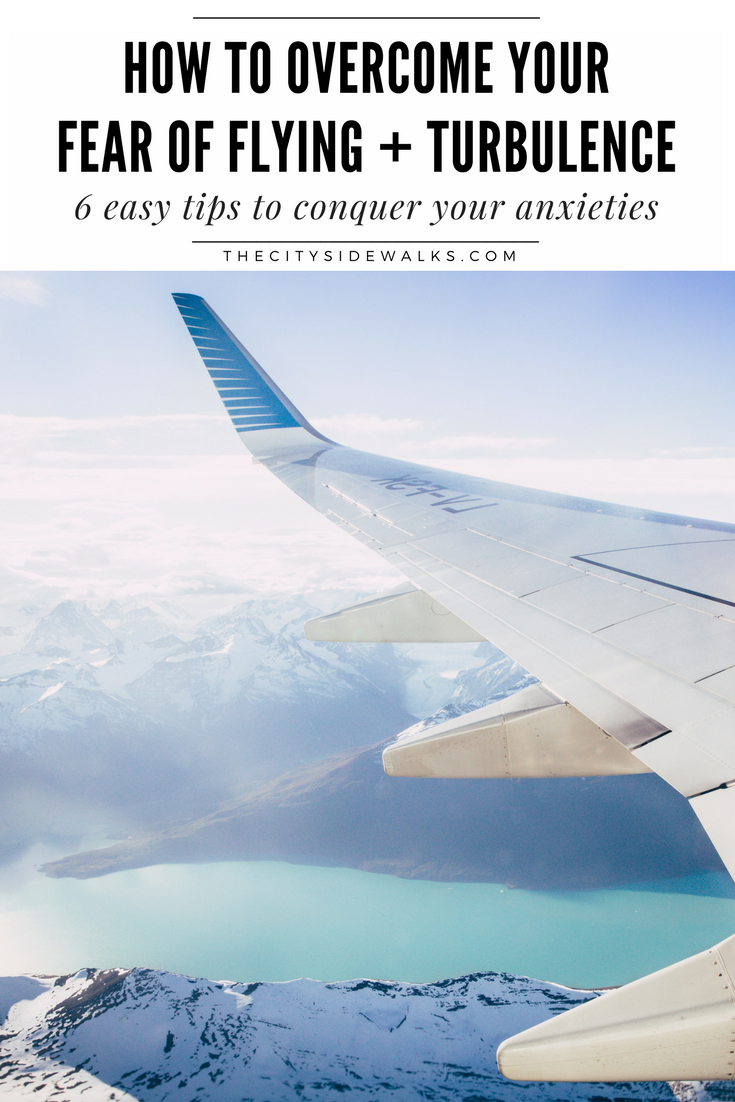How to Overcome Your Fear of Flying: 6 Easy Tips to Conquer Your Anxieties
How to Overcome Your Fear of Flying: 6 Easy Tips to Conquer Your Anxieties
“Oh shit... Here it goes again. Just try to breathe. Just breathe. Try to stay calm.”
My fists white knuckle into the armrests as my entire upper body is folded over my lap with my head in between my legs. My eyes are closed tight and I can feel the fear and pain begin to wash over my body. My heart is pounding and feels like it’s beating out of my chest. The fear is beginning to take over and every millimeter of movement starts to feel like imminent death.
“This is it. I can’t hold it in anymore. I don’t care what people think anymore.” I continue think to myself. “No, Ana! JUST BREATHE. YOU GOT THIS! BREATHE. IN. OUT.” It was like I was stuck in the middle of a game my brain was playing where it was being both the angel and the devil and I didn’t know which one to listen to.
But I couldn’t hold it in anymore. The fear had won this time.
“Oh fuck... Here come the tears...” I think to myself as an uncontrollable stream of “Kim Kardashian ugly cry” sized tears and sobs start wailing out of me. I don’t even care that people are staring at this point. I can’t stop it. It won’t stop. My mind has gone into complete survival mode and I’ve abandoned all sense of reasoning and logic to make myself stop crying. The panic attack has set in.
It was my first full-fledged panic attack on an airplane thanks to my fear of flying and turbulence. If it wasn’t for the kind woman sitting next to me in 7B who felt so bad that she held my hand and rubbed my back as I was sobbing, I don’t know what I would’ve done or how much longer it would have lasted. Although, we did have a good laugh once we landed safely and she asked me what I did for a living. “I’m a travel blogger,” I said timidly. The sheer irony of the person who travels for a living having an epic meltdown in the air—something that most people think I’d be used to by now—was pretty comical after the moment ended.
But it’s true. And now I’m letting my fears be known to the world.
My name is Ana Dominguez and I have a fear of flying.
It's shocking for a person who travels so much—I know.
Uttering the words (and even writing them) is such a bizarre thing to me, though, because I wasn’t always like this. I used to get such a thrill from the feeling of taking off or being in the air. But somewhere along the way, that feeling turned sour.
Maybe Hollywood is to blame for making movies about aircraft tragedies. Maybe airline corporations are to blame for making their cabins feel increasingly more claustrophobic. Maybe the media is to blame for broadcasting every tiny detail that goes wrong with/on airplanes these days. Maybe it’s just getting older and being more aware of the perils of everyday life. I don’t really know what it was, but something switched in my head within the last 10 years that triggered my fear of flying and turbulence (or rather the fear of falling to my death from the sky) that still affects me every single time I step foot on a plane.
Truth be told, I’ve actually gotten much better at coping with my fear (and am even writing this article while sitting on a plane that has already had a couple of uncomfortable bumps), which was one of my intentions of writing this. I’m hoping that by vocalizing this fear and sharing how I’ve been able to cope with it, it will work as some sort of therapeutic release in the sense that I’m letting the energy go while also helping others overcome their fears. Plus, now you can have someone to relate to!
Which brings me to my second intention of writing this article: I want to share all of the methods and things that I’ve done over the last couple of years to learn how to conquer this fear. And, no, I didn’t spend thousands of dollars on hypnosis (although that would be pretty cool, now that I think about it...). These 6 tips are all simple, little things that you can start doing today and even use on your next trip to overcome your fear of flying!
1. Breathe like a Yogi
If you’ve ever taken a human biology class, a yoga class, or even learned about basic physiology, you’ve probably heard all about the importance of breathing and receiving oxygen to the brain. One of the top reasons why our brains start to go into panic mode whenever they do is because they aren’t receiving enough oxygen to properly operate and function as they would if things were calm. That’s why it’s so important to remember to breathe whenever you’re going through something stressful—whether it’s emotional, mental, or physical.
For me, learning how to meditate (which, thanks to technology, can be done by watching a single YouTube video) and properly breathe has really come in handy during my moments of flight panic.
But did you catch what I just said there? *PROPERLY* breathe. Not just regular breathing, but expert breathing. It’s more than just taking a breath in and out. There are actually ways for you to do it so that you can calm yourself down and get the most oxygen possible. Here are my two favorite ways:
- Belly Breathing:
Take a deep breath in and a deep breath out right now. If your shoulders move up and down while you’re doing it, you’re doing it wrong. To really get the most oxygen while breathing, focus on breathing in deep through the belly and visualize your diaphragm and stomach filling up with as much air as you can possibly take in. Your shoulders shouldn’t be moving up and down and your upper body shouldn’t be doing much either. When you breathe out, let out every bit of air as if you were a balloon becoming completely deflated. Now do this to counts. Breathe in for 3-5 counts and breathe out for 3-5 counts. Slowing down the breath like this will help the flow of oxygen in your system and get you more relaxed.
- Single Nostril Breathing:
This is a great technique I learned from a friend of mine who also deals with anxieties and panic attacks. I love this one because it forces you to focus on the breathing technique instead of your fears or anxieties. You’re going to use the thumb, index finger, and middle finger of one of your hands for this. Choose a hand and place the index finger directly above the bridge of your nose on your third eye. Place the thumb on one nostril to cover it up and breath deeply through the other nostril that is open. Once you have breathed in all the air you can through that open nostril, use your middle finger to cover up the nostril that was just open and breathe out through the nostril that was just closed. Now breathe in through that same nostril, close it with the thumb, and breathe out the other nostril. Keep alternating and repeat this until you feel like you have reached a steady pace of breathing or your anxiety has subsided. Like I said, I love this one because it helps me take my mind off of what’s going on around me.
I can’t even stress enough how important breathing is when you’re feeling panicked on a flight (or any situation, for that matter). I know I’m guilty of forgetting to do this sometimes, but breathing properly has definitely come in handy more times than I could count.
Bonus: If you really want to step up your relaxation game, you can buy a small bottle of lavender oil to dab on your wrists or put inside your palms to breathe in while you’re practicing these exercises. I always carry a small bottle with me in my carry-on bag just in case I need it.
2. Have a designated meditation or calming playlist ready to go on your phone
In addition to the breathing techniques, I’ve learned that having a soothing playlist to listen to can really help put you in the zone and focus your mind on calming down.
I personally love using Spotify and have even created my own designated playlist of meditation music to listen to whenever I start feeling anxious. It helps put me at ease and tells my brain, “It’s time to chill out.” But you don’t necessarily have to use meditation music. Whatever genre of music works to put you in that relaxation mood, use it on your own personal playlist.
3. BOSE. NOISE. CANCELING. HEADPHONES.
I know that I said all of these tips were going to be cheap and easy enough to start doing now, but this one is the exception to the rule. But I promise it’s an exception for a very good reason.
For me, one of the biggest sources of my anxiety on planes is the noise that comes from the aircraft bumping and shaking (screaming children don’t help either...). You know what I’m talking about, right? It’s those creaky, bumpy sounds that happen when turbulence starts to set in. Yep, I can’t stand it. It makes me feel like death is upon me. The only solution to this was to start listening to calming music (as mentioned in #2) to put me at ease.
I used to use regular headphones on flights like most people and they worked fine. But, a couple years ago on my birthday, my mom got me quite possibly the best gift ever for my flying anxiety: a pair of Bose Noise Canceling Earbuds.
OH, BUDDY, DID THESE DO THE TRICK!
Popping those babies in took me to a whole new world. As soon as I turned them on and started my meditation playlist, I was immediately transported to my own personal oasis away from all the noise, fears, and anxieties of traveling. It was like a switch had flipped and I wasn’t as nervous anymore since I couldn’t hear the noises of the aircraft.
Sure, the bumps of turbulence are still there; but it feels a wholeeee lot different when you can’t actually hear what’s going on. Kinda takes the edge off, if you will. I swear by these headphones and 100% recommend them (or any type of noise cancelling headphones) for people who have trouble with flying.
FYI—if you can’t splurge on headphones, you can also just get a nice pair of earplugs. I personally prefer and recommend the headphones because you can put on soothing music, but whatever works for you!
4. Watch the flight attendants
I learned this tip from a flight attendant who was sitting next to me on another nail-biting turbulence tunnel. He saw how nervous I was getting with every shake and bump and assured me that everything was totally fine. He said something along the lines of, “Look, we do this multiple times a day, every day. We can tell when the bumps are fine and when they are REALLY not fine. 98% of the time, it’s totally fine and nothing to worry about.”
He suggested to me that any time I start to feel nervous when things get a little shaky to just take cues from the flight attendants. Look up to find them and see how they are reacting. Are they panicking? No? Ok, then you shouldn’t either. You’ll be able to tell how things are really going based on how chill (or not chill) they are. Most of the time, when the pilot tells everyone to get back to their seats, it’s just a precautionary measure. You can even see how little it affects the flight attendants as they’re Instagramming or chatting it up with their co-workers.
5. Talk to a pilot
I know this one is a little unconventional, but if you ever get the chance to talk to a pilot about the science of flying, do it. I once struck up a conversation with a pilot that I met on the streets of London and we started talking about turbulence over the Atlantic Ocean. As soon as he started explaining exactly what turbulence was and how safe we actually were in that flying steel bird, it sorta put me at ease. It’s almost like the mystery of what was going on and the fear that we were going to fall out of the sky because of turbulence had melted away.
My new friend explained to me that these massive aircrafts are built to withstand tons of turbulence, which is a really just a strong gust of wind when you think about it. Often times, when you feel like the plane just dropped hundreds of feet, that’s just your headspace getting in the way; it’s actually only a couple of inches or feet, which is nothing in the grand scheme of things. He also explained how it’s literally impossible to fall out of the sky when you’re flying and that you’re safer in a plane than you are in a car.
I’m telling you—learning a little bit of the science behind flying helped me a lot. For instance, did you know that an airplane could fly safely with only one engine and land without any? Incredible! All these facts shed some light on the scary stuff and made me better understand what was really happening. Maybe learning how to fly or becoming a pilot should be my next step in overcoming my fears...
6. Reframe your thought process
Thoughts are EVERYTHING! The power of positive thinking can really come in handy for every situation, even flying. If you can start to tell yourself that everything is fine and you’re totally safe, eventually your brain will start to believe it. Think positive thoughts and reframe your thought process into something better.
Another travel friend of mine said that any time she starts to feel the plane get shaky, she just thinks of it as a little, harmless road bump. One time she told me, “Well, what’s the worst that can happen? A drink falls over? Meh! That’s nothing.” So that’s what she has taught her brain to think: The worst thing that will happen is a drink will fall over, which you can easily clean up. It’s much better to fill your head with less catastrophic outcomes like this one.
What about the booze?
I don’t recommend this every time, but sometimes a cocktail or a glass of wine can definitely help to relax the nerves a bit. This needs to be done with caution, though, because too much alcohol can dehydrate you and reap horrors for your complexion and system. It can even negatively trigger anxiety since alcohol is a depressant. But I’d be a hypocrite if I didn’t say that I’ve had a couple glasses of Sauvignon Blanc to calm down from the panic of flying...
No mention of Xanax or pills, either?
If this method works for you, that’s great! There are some people who actually really need some kind of substance(s) to calm the nerves, which is totally fine as long as your doctor recommends it and is supervising your dosage. I don’t personally subscribe to this method of relaxation because I try to be as homeopathic with my medication and remedies as possible, but I’m not against it. I just prefer other ways of easing the tension.
Like I said earlier, all of these methods and practices are things that I’ve learned over the last few years of traveling in order to deal with my anxieties. If you have issues with flying, use one, none, or all of them if you’d like! The key here is to acknowledge and confront your fears in a healthy manner and figure out what works best for you.


















